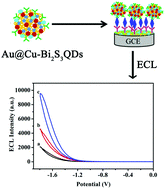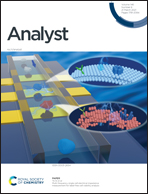Ultrasensitive detection of cyclin D1 by a self-enhanced ECL immunosensor based on Bi2S3 quantum dots†
Abstract
Bismuth sulfide quantum dots (Bi2S3 QDs), which have excellent optical and thermoelectric properties, represent a green and non-toxic semiconductor material that has been widely used in catalysis and photoelectric conversion devices. At present, research on this material has gradually expanded into the biological field. Herein, the biomineralization method mediated by bovine serum albumin (BSA) was utilized to synthesize Bi2S3 QDs with monodispersity, excellent colloidal stability, and good biocompatibility. This is the first study on the electrochemiluminescence (ECL) characteristics of Bi2S3 QDs and related ECL mechanisms in detail. In addition, on the basis of Bi2S3 QDs, an ECL immunosensor was used for the ultrasensitive measurement of cyclin D1 (CCND1). The composite material, namely Au@Cu-Bi2S3 QDs was used as a high-sensitivity ECL probe, in which AuNPs were connected with Bi2S3 QDs through a copper(II) ion bridge. PDA-AgNPs made of dopamine (DA) and silver nanoparticles (AgNPs) were utilized as a carrier for fixing the primary antibody (Ab1), ultimately presenting a relatively wide detection range of 10 fg mL−1–1 μg mL−1. Moreover, quite a low detection limit (6.34 fg mL−1) was also obtained for an assay of CCND1. Results indicated that the immunosensor can provide a potential platform with fine stability and creditable reproducibility for clinical diagnosis.



 Please wait while we load your content...
Please wait while we load your content...